Even before qualified tech help got so hard to find and keep, boundary mics and automixing devices had made their mark on the conferencing and broadcast industries. Now that staffing is so tight, boundary mics allow simplified conference room sound pickup while automixers quell acoustic ringing and boost gain before feedback. It is almost as if automixing inventor Dan Dugan and other sound innovators saw today’s environment coming. The devices featured here demonstrate how far we have come in these two key technologies.
 A proven performer, the AKG PCC170 professional boundary layer microphone teams a bass-tilt switch and a super-cardioid polar pattern with superior RFI suppression to produce clear vocal pickup and avoid cellphone interference. For even more user control, the PCC170 SW provides a programmable membrane switch that can be set up for touch on/ off, momentary on or momentary off operation modes. It accepts 12-48VDC phantom power on the detachable cable and a Switchcraft TB3M connection makes it easy to pack up and transport. The 50Hz-20kHz response provides full-bodied sound.
A proven performer, the AKG PCC170 professional boundary layer microphone teams a bass-tilt switch and a super-cardioid polar pattern with superior RFI suppression to produce clear vocal pickup and avoid cellphone interference. For even more user control, the PCC170 SW provides a programmable membrane switch that can be set up for touch on/ off, momentary on or momentary off operation modes. It accepts 12-48VDC phantom power on the detachable cable and a Switchcraft TB3M connection makes it easy to pack up and transport. The 50Hz-20kHz response provides full-bodied sound.  Also from AKG is the AKF DMM8-UL professional digital automatic microphone mixer with its Ethernet connection. For sound control on very large meetings and conferences, up to ten of these units can be cascaded for as many as 80 channels of automixing. Controllable parameters include filters, compressor/ limiter, ducking and routing. These and other functions can be controlled from a world away on the LAN interface. There is also a ULD version of the mixer that features Dante connectivity and the ability of each input to feed a direct output for broadcasting and recording
Also from AKG is the AKF DMM8-UL professional digital automatic microphone mixer with its Ethernet connection. For sound control on very large meetings and conferences, up to ten of these units can be cascaded for as many as 80 channels of automixing. Controllable parameters include filters, compressor/ limiter, ducking and routing. These and other functions can be controlled from a world away on the LAN interface. There is also a ULD version of the mixer that features Dante connectivity and the ability of each input to feed a direct output for broadcasting and recording
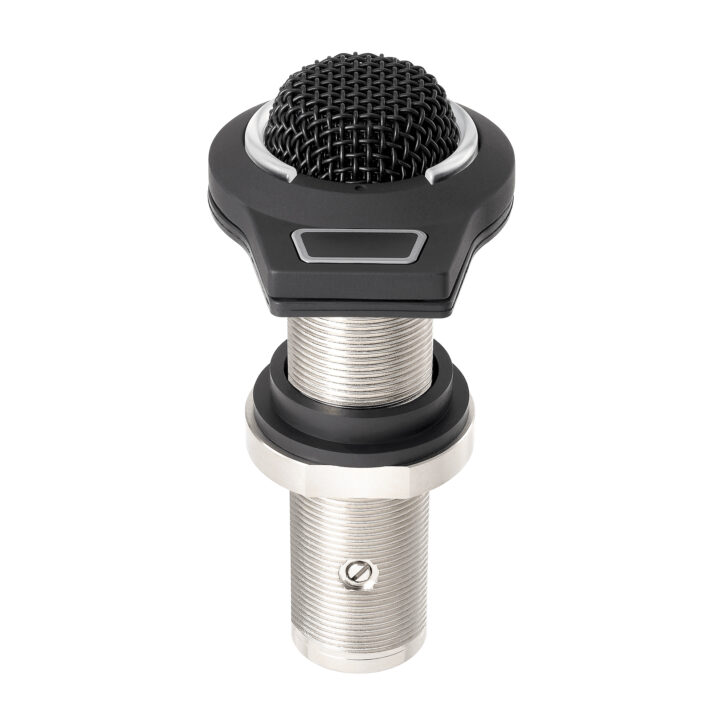 Maximum conference sound coverage with minimum physical profile are assured when the Audio-Technica ES947C/FM3 is mounted directly into a conference table while showing off its two-state RGB LED ring. For this, there are 7 selectable colors to clearly indicate the microphone’s mute status. This model has a 120-degree pickup angle from its tough metal case and twolayer steel mesh grille. For protection against radio frequency interference the system uses UniGuard RFI-shielding. Producing less clutter, the power module is internal and for optional isolation from the mounting surface, a pair of rubber isolators can be added.
Maximum conference sound coverage with minimum physical profile are assured when the Audio-Technica ES947C/FM3 is mounted directly into a conference table while showing off its two-state RGB LED ring. For this, there are 7 selectable colors to clearly indicate the microphone’s mute status. This model has a 120-degree pickup angle from its tough metal case and twolayer steel mesh grille. For protection against radio frequency interference the system uses UniGuard RFI-shielding. Producing less clutter, the power module is internal and for optional isolation from the mounting surface, a pair of rubber isolators can be added.  The Audio-Technica ATDM-0604 automatic mixer fits well into a wide range of meeting spaces including boardrooms and courtrooms. Its SmartMixer technology allows channels to be mixed automatically in gate or gain sharing mode while controlling feedback, excessive ambient noise, and comb filtering. The unit also has a 2-channel USB audio interface for soft codec integration or playback from computer.
The Audio-Technica ATDM-0604 automatic mixer fits well into a wide range of meeting spaces including boardrooms and courtrooms. Its SmartMixer technology allows channels to be mixed automatically in gate or gain sharing mode while controlling feedback, excessive ambient noise, and comb filtering. The unit also has a 2-channel USB audio interface for soft codec integration or playback from computer.
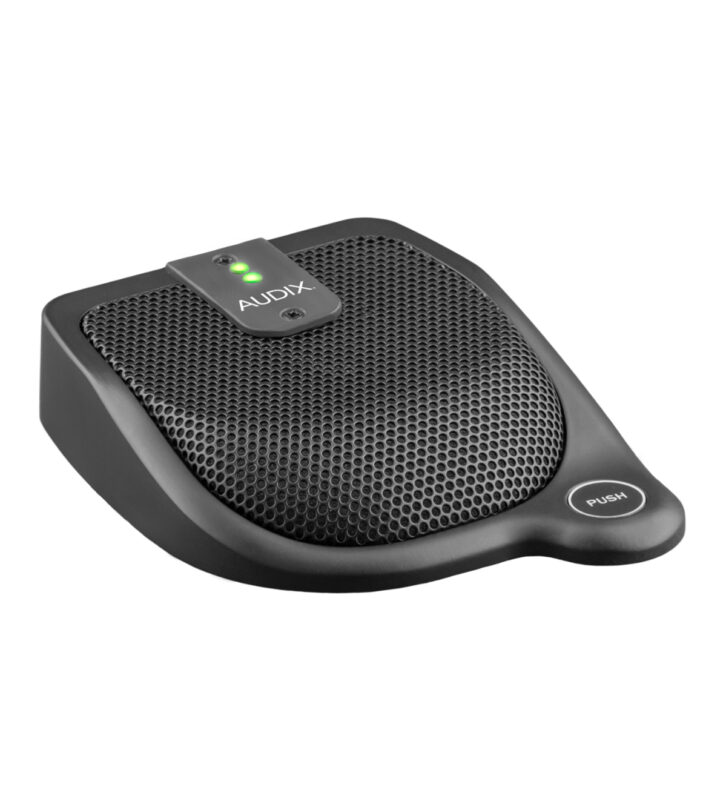 Since their introduction, boundary microphones have evolved into sophisticated, multi-modal devices and the Audix M63 condenser boundary mic is a perfect example of this trend. Featuring an integral, ergonomic pushbutton with programmable functions, the mic can use it for on/off as well as momentary talk/mute and there are red and green LED status lights on the top of the housing. There is also a patented internal shock-mount suspension system along with a slide resistant rubber base. This model also does well in RFI environments due to its extensive shielding and it uses the Micros series technology for best sound clarity and reliable operation.
Since their introduction, boundary microphones have evolved into sophisticated, multi-modal devices and the Audix M63 condenser boundary mic is a perfect example of this trend. Featuring an integral, ergonomic pushbutton with programmable functions, the mic can use it for on/off as well as momentary talk/mute and there are red and green LED status lights on the top of the housing. There is also a patented internal shock-mount suspension system along with a slide resistant rubber base. This model also does well in RFI environments due to its extensive shielding and it uses the Micros series technology for best sound clarity and reliable operation.
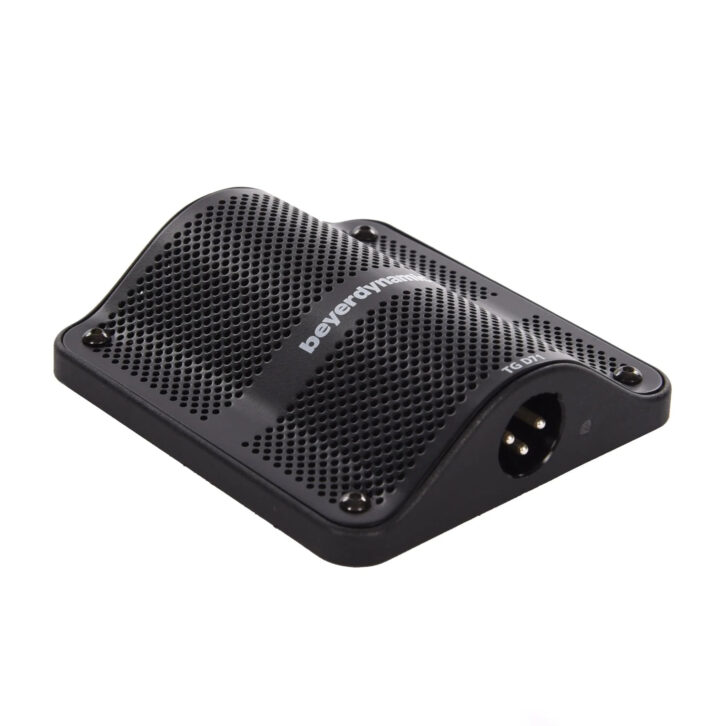 One of the most tough and durable boundary mics out there today is the beyerdynamic TG D71 semi-cardioid model and its wide range of uses includes kick drums, pianos and other percussion instruments. Its maximum sound pressure level of 148dB handles all these applications easily. The shape of the housing and its rubberized underside assure that the mic will remain in proper position. It can even be secured to a vertical surface using screw mounting holes on the bottom. Along with its 25Hz-20kHz frequency response, the TG D71 features a 3-pin XLR connector built into the case and a range of 12 to 48VDC phantom power operating capability.
One of the most tough and durable boundary mics out there today is the beyerdynamic TG D71 semi-cardioid model and its wide range of uses includes kick drums, pianos and other percussion instruments. Its maximum sound pressure level of 148dB handles all these applications easily. The shape of the housing and its rubberized underside assure that the mic will remain in proper position. It can even be secured to a vertical surface using screw mounting holes on the bottom. Along with its 25Hz-20kHz frequency response, the TG D71 features a 3-pin XLR connector built into the case and a range of 12 to 48VDC phantom power operating capability.
 The CAD Audio U5 USB condenser boundary microphone can be placed in the middle of a conference table and with its omnidirectional polar pattern it can pickup all participants. The -30dB sensitivity enables it to hear attendees at distances up to 20ft. With a frequency response of 20Hz to 20kHz and 16-bit 48kHz processing, the sound is robust and full. Built-in noise cancellation keeps the conference or lecture pickup free of background sounds. Users don’t need amp or mixer access because the clearly marked volume and mute controls are right on the housing.
The CAD Audio U5 USB condenser boundary microphone can be placed in the middle of a conference table and with its omnidirectional polar pattern it can pickup all participants. The -30dB sensitivity enables it to hear attendees at distances up to 20ft. With a frequency response of 20Hz to 20kHz and 16-bit 48kHz processing, the sound is robust and full. Built-in noise cancellation keeps the conference or lecture pickup free of background sounds. Users don’t need amp or mixer access because the clearly marked volume and mute controls are right on the housing.
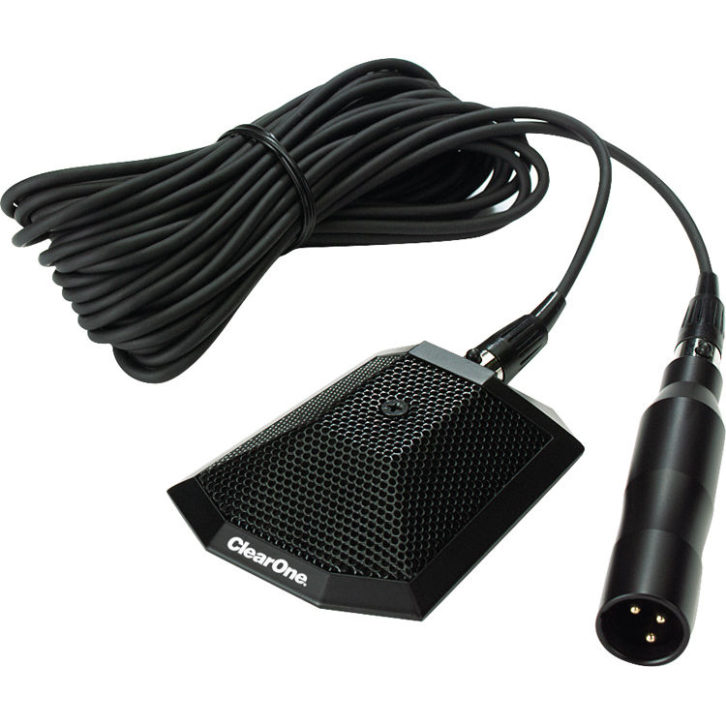 With the microphone at the video display end of a conference table the ClearOne Uni-Directional Tabletop Microphone minimizes the remote audio and gets the sound from all the table positions. With its low profile it blends into the room and the 23ft. cable can reach the videoconferencing mixer or processor without cluttering the table. The 15Hz-18kHz response is well suited to speech and a maximum SPL of 141dB can handle any sudden loud sounds and mechanical impacts. The mic runs on 9-52VDC phantom power and its A3M terminal is a standard connector that fits a wide variety of sound inputs.
With the microphone at the video display end of a conference table the ClearOne Uni-Directional Tabletop Microphone minimizes the remote audio and gets the sound from all the table positions. With its low profile it blends into the room and the 23ft. cable can reach the videoconferencing mixer or processor without cluttering the table. The 15Hz-18kHz response is well suited to speech and a maximum SPL of 141dB can handle any sudden loud sounds and mechanical impacts. The mic runs on 9-52VDC phantom power and its A3M terminal is a standard connector that fits a wide variety of sound inputs.
 Dedicated conference facilities can have their microphones built-in for the least obtrusive appearance and the body of the Clockaudio C004E-RF screws right into a .94-inch diameter hole drilled into the table surface. Once installed it protrudes less than an inch above the surface and runs on 9-48VDC phantom power through a cable that is completely out of sight. This model is available in satin black or white and its cardioid polar pattern allows it to reject background sound from the other areas of the room. Interference from cellphones is filtered out as well as mechanical shock due to the microphone’s rubber isolators.
Dedicated conference facilities can have their microphones built-in for the least obtrusive appearance and the body of the Clockaudio C004E-RF screws right into a .94-inch diameter hole drilled into the table surface. Once installed it protrudes less than an inch above the surface and runs on 9-48VDC phantom power through a cable that is completely out of sight. This model is available in satin black or white and its cardioid polar pattern allows it to reject background sound from the other areas of the room. Interference from cellphones is filtered out as well as mechanical shock due to the microphone’s rubber isolators.
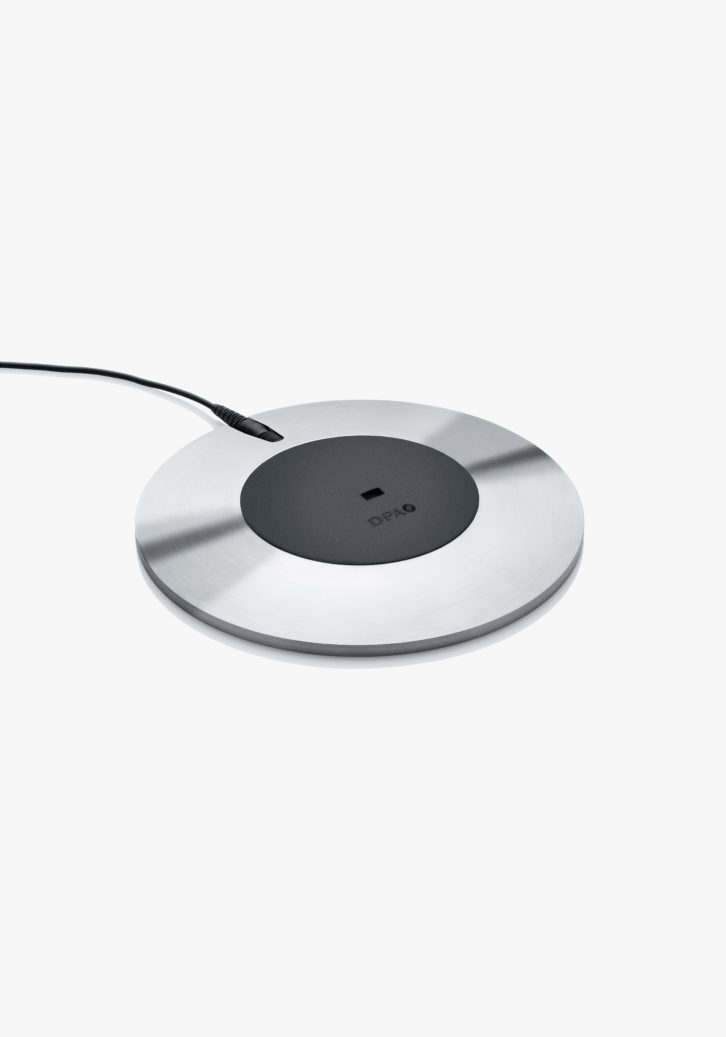 The DPA Microphones 4060 Omni Boundary Layer Mic can be used in conference facilities, courtrooms and lecture halls. Compatible for either XLR or MicroDot termination, the pre-polarized condenser mic offers 20Hz-20kHz frequency response and provides maximum sound pressure handling of 134 dB SPL. The housing consists of a black rubber disc mounted in a stainless-steel base. Any solid surface will work for placement and the mic even works well on a tablecloth. Included is the DAD6001 Adapter for MicroDot to 3-pin XLR with belt clip. The extremely low physical profile avoids blocking of sightlines to papers, notes and fellow conference participants.
The DPA Microphones 4060 Omni Boundary Layer Mic can be used in conference facilities, courtrooms and lecture halls. Compatible for either XLR or MicroDot termination, the pre-polarized condenser mic offers 20Hz-20kHz frequency response and provides maximum sound pressure handling of 134 dB SPL. The housing consists of a black rubber disc mounted in a stainless-steel base. Any solid surface will work for placement and the mic even works well on a tablecloth. Included is the DAD6001 Adapter for MicroDot to 3-pin XLR with belt clip. The extremely low physical profile avoids blocking of sightlines to papers, notes and fellow conference participants.
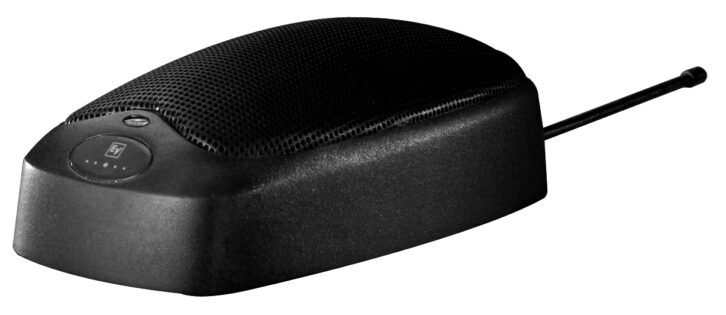 The Electro-Voice PC Boundary Satellite is a wireless multi-pattern boundary layer microphone that operates with EV and Telex bodypack transmitters. Maximum versatility is achieved through the use of its ability to switch between omni, cardioid, supercardioid, or figure-eight polar patterns. On the housing, the mute switch is programmable for either latching on/off or momentary-on. The mic’s 50Hz-20kHz frequency response allows high quality transmission and recording. The black case blends into most conference tables and its steel construction assures durability and long-lasting service.
The Electro-Voice PC Boundary Satellite is a wireless multi-pattern boundary layer microphone that operates with EV and Telex bodypack transmitters. Maximum versatility is achieved through the use of its ability to switch between omni, cardioid, supercardioid, or figure-eight polar patterns. On the housing, the mute switch is programmable for either latching on/off or momentary-on. The mic’s 50Hz-20kHz frequency response allows high quality transmission and recording. The black case blends into most conference tables and its steel construction assures durability and long-lasting service.
 When the conference has to work or else, the Sennheiser SL Boundary 114-S DW gives the user plenty of ways to do it reliably. Compatible with the Sennheiser SL Rack Receiver DW, the mic has a half-cardioid pickup that cuts background noise. The button on the top of the housing can be programmed to operate in push-to-talk, push-to-mute, toggle on/off, and permanent on. The mic status on these selections is clearly shown by a two-color LED. This model features inductive wireless and/or USB cable charging. This provides the ultimate in freedom from the amateurish appearance of wiring clutter on the table. The mic can be monitored and controlled remotely with the Sennheiser Control Cockpit. The 40Hz-20kHz frequency response makes local participants sound as if they are in the same room with remote users.
When the conference has to work or else, the Sennheiser SL Boundary 114-S DW gives the user plenty of ways to do it reliably. Compatible with the Sennheiser SL Rack Receiver DW, the mic has a half-cardioid pickup that cuts background noise. The button on the top of the housing can be programmed to operate in push-to-talk, push-to-mute, toggle on/off, and permanent on. The mic status on these selections is clearly shown by a two-color LED. This model features inductive wireless and/or USB cable charging. This provides the ultimate in freedom from the amateurish appearance of wiring clutter on the table. The mic can be monitored and controlled remotely with the Sennheiser Control Cockpit. The 40Hz-20kHz frequency response makes local participants sound as if they are in the same room with remote users.
 Automixing started here and the Dan Dugan Sound Design E-3A Automatic Mixing Controller is an established standard performer in the industry. Each unit offers 32-channels of processing, 16 AES plus 16 ADAT inputs. Within its features are all Dugan algorithms: Speech System, Music System and Gain Limiting as well as a six-bus pre/post matrix mixer. All of these channels may be grouped into three independent automixers. The E-3A is PoE capable and there are three switched Ethernet ports available to function on a control network. Remote operation is possible through the Dugan Control Panel for Java which is included and Dugan Control Panel for iPad which is an option sold separately.
Automixing started here and the Dan Dugan Sound Design E-3A Automatic Mixing Controller is an established standard performer in the industry. Each unit offers 32-channels of processing, 16 AES plus 16 ADAT inputs. Within its features are all Dugan algorithms: Speech System, Music System and Gain Limiting as well as a six-bus pre/post matrix mixer. All of these channels may be grouped into three independent automixers. The E-3A is PoE capable and there are three switched Ethernet ports available to function on a control network. Remote operation is possible through the Dugan Control Panel for Java which is included and Dugan Control Panel for iPad which is an option sold separately.
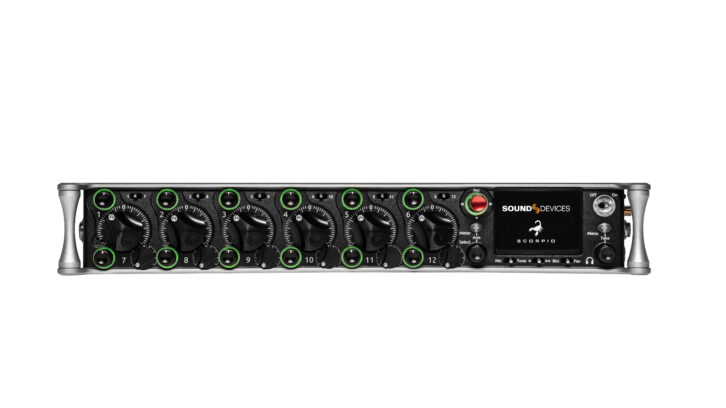 It’s like taking a recording studio on the road with the Sound Devices Scorpio premium portable mixer-recorder, a 32 channel, 12 bus, 36 track machine. These devices include 32 channels of Dante I/O and 16 ultra-low noise, 8-Series microphone preamplifiers. Recording is done on 256GB internal SSD through two SD card slots. For the automix, it offers Dugan Automixing/ MixAssist for up to 16 channels. The fully-customizable routing matrix allows any input to be sent to any channel, bus, or output and all of this capability is in an over-the-shoulder unit that can go anywhere. The award-winning Scorpio uses FPGA-based audio processing with 64-bit data paths for the best in sound quality and it includes built-in analog limiters, high pass filters, delay, 3-band EQ and phantom power.
It’s like taking a recording studio on the road with the Sound Devices Scorpio premium portable mixer-recorder, a 32 channel, 12 bus, 36 track machine. These devices include 32 channels of Dante I/O and 16 ultra-low noise, 8-Series microphone preamplifiers. Recording is done on 256GB internal SSD through two SD card slots. For the automix, it offers Dugan Automixing/ MixAssist for up to 16 channels. The fully-customizable routing matrix allows any input to be sent to any channel, bus, or output and all of this capability is in an over-the-shoulder unit that can go anywhere. The award-winning Scorpio uses FPGA-based audio processing with 64-bit data paths for the best in sound quality and it includes built-in analog limiters, high pass filters, delay, 3-band EQ and phantom power.
 Another proven performer in the automixing arena is the Lectrosonics DNT16i Digital Processor providing inputs into a Dante network from analog and digital signals. This powerful device has 48 independent automatic mixers with 36 inputs per mixer and channel activity detectors. Among these, mixes can be looped back and used as mixer inputs. In addition, there is extensive DSP including filters, delay and channel linking for dynamic processing. For initial setup there are four test signal generators to aid in configuration and balancing. Control connections include USB, RS-232, Ethernet and programmable logic I/O. Included are DNT software, an adjustment tool, 5-position plugs, USB cable, power cord and a 25-pin connector. The DNT16i processor can be rack mounted but it is also small enough to mount under a table
Another proven performer in the automixing arena is the Lectrosonics DNT16i Digital Processor providing inputs into a Dante network from analog and digital signals. This powerful device has 48 independent automatic mixers with 36 inputs per mixer and channel activity detectors. Among these, mixes can be looped back and used as mixer inputs. In addition, there is extensive DSP including filters, delay and channel linking for dynamic processing. For initial setup there are four test signal generators to aid in configuration and balancing. Control connections include USB, RS-232, Ethernet and programmable logic I/O. Included are DNT software, an adjustment tool, 5-position plugs, USB cable, power cord and a 25-pin connector. The DNT16i processor can be rack mounted but it is also small enough to mount under a table
 Introduced at InfoComm 2023, the new MXL AC83 Bluetooth LE 5.0 Enabled Boundary Microphone brings a substantial degree of flexibility to the conferencing industry. Its Bluetooth capability allows it to transmit up to 200ft. so cumbersome cabling is not a problem. Based on a 3-capsule design, the AC83 can emphasize direct sound while minimizing surrounding input. Cabling is eliminated not only by the RF transmission but also by the device’s 36-hour continuous battery operation.
Introduced at InfoComm 2023, the new MXL AC83 Bluetooth LE 5.0 Enabled Boundary Microphone brings a substantial degree of flexibility to the conferencing industry. Its Bluetooth capability allows it to transmit up to 200ft. so cumbersome cabling is not a problem. Based on a 3-capsule design, the AC83 can emphasize direct sound while minimizing surrounding input. Cabling is eliminated not only by the RF transmission but also by the device’s 36-hour continuous battery operation.
 The RCF MC 5002 Professional Desktop Microphone is encased in a white durable metal housing and this extends less than an inch and a half above the surface on which it is placed. Running on 12-48VDC phantom power on a mini XLR connection, the electret condenser mic has a unidirectional polar pattern and frequency response of 50Hz-18kHz for great voice pickup. A 3ft. audio cable is included with additional conductors for dry contact control. When the mic is turned on, a red LED on the case is illuminated. The system is equipped for three mode functions. These are Flat, Boost, and Low Cut. Each presents a different emphasis on the frequency response to suit specific applications and sound environments.
The RCF MC 5002 Professional Desktop Microphone is encased in a white durable metal housing and this extends less than an inch and a half above the surface on which it is placed. Running on 12-48VDC phantom power on a mini XLR connection, the electret condenser mic has a unidirectional polar pattern and frequency response of 50Hz-18kHz for great voice pickup. A 3ft. audio cable is included with additional conductors for dry contact control. When the mic is turned on, a red LED on the case is illuminated. The system is equipped for three mode functions. These are Flat, Boost, and Low Cut. Each presents a different emphasis on the frequency response to suit specific applications and sound environments.
 A multi-channel networked boundary microphone, the Shure MXA310 can customize its pickup pattern, auto-mix its various pickup zones and fully interface with a networked system using one cable for power (PoE), control and audio. There is an LED ring that can be configured to show muting status in Ring, Segment or Automix in two colors. Available in white, black, or aluminum, the mic case can blend easily into any room décor and each of its five audio channels has a selectable pickup pattern. Ten presets can be set up, stored and recalled through web-based software control. The MXA310 can be used on top of the table or mounted into the surface with the A310-FM flush mount. For a separate and well-proven automixing solution, there is the
A multi-channel networked boundary microphone, the Shure MXA310 can customize its pickup pattern, auto-mix its various pickup zones and fully interface with a networked system using one cable for power (PoE), control and audio. There is an LED ring that can be configured to show muting status in Ring, Segment or Automix in two colors. Available in white, black, or aluminum, the mic case can blend easily into any room décor and each of its five audio channels has a selectable pickup pattern. Ten presets can be set up, stored and recalled through web-based software control. The MXA310 can be used on top of the table or mounted into the surface with the A310-FM flush mount. For a separate and well-proven automixing solution, there is the 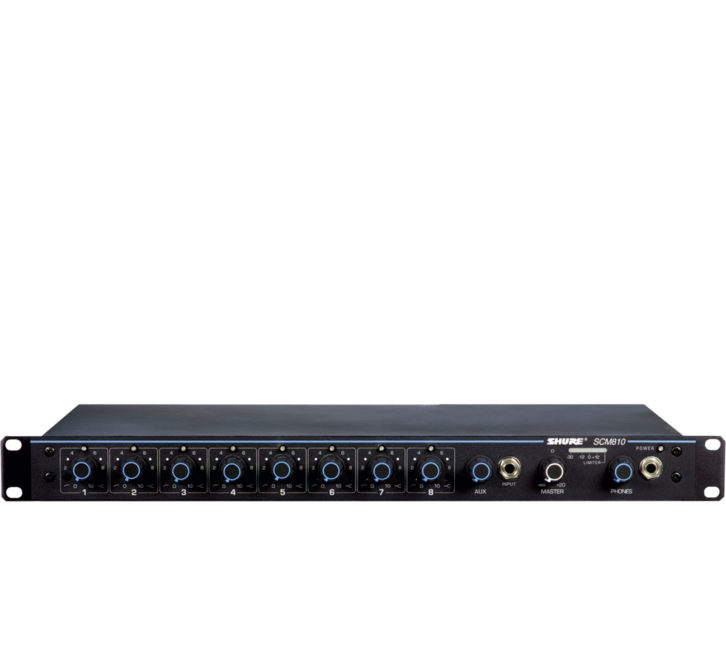 Shure SCM810 rack mount 8-channel automatic mixer with individual level controls, master level control and a separate headphone output with its own level control. In addition to the 8 mic inputs there is also a high-level Aux input. Each channel has adjustable EQ, selectable 48VDC phantom power and there is complete logic control of microphone activation. With multiple units, up to 400 mics can be linked. In addition to the 8 balanced mic-line input channels there are also unbalanced 1/4in. direct line level outputs.
Shure SCM810 rack mount 8-channel automatic mixer with individual level controls, master level control and a separate headphone output with its own level control. In addition to the 8 mic inputs there is also a high-level Aux input. Each channel has adjustable EQ, selectable 48VDC phantom power and there is complete logic control of microphone activation. With multiple units, up to 400 mics can be linked. In addition to the 8 balanced mic-line input channels there are also unbalanced 1/4in. direct line level outputs.
 The award winning Sound Devices Scorpio 32 channel, 36 track mixer-recorder has among its wealth of features Dugan Automixing/MixAssist for up to 16 channels. The mixer also features 16 mic/line preamplifiers, 32 channels of Dante in and out, AES in and out, 12 analog outputs, multiple headphone outputs, and a fully-customizable routing matrix that allows any input to be sent to any channel, bus, or output. In addition, the inputs offer built-in analog limiters, high pass filters, delay, 3-band EQ and phantom power. Two separate groups can be mixed simultaneously while LED metering and a sunlight-readable screen show Dugan channel attenuation and gain distribution. The Scorpio can be used in-studio or on the road with battery power
The award winning Sound Devices Scorpio 32 channel, 36 track mixer-recorder has among its wealth of features Dugan Automixing/MixAssist for up to 16 channels. The mixer also features 16 mic/line preamplifiers, 32 channels of Dante in and out, AES in and out, 12 analog outputs, multiple headphone outputs, and a fully-customizable routing matrix that allows any input to be sent to any channel, bus, or output. In addition, the inputs offer built-in analog limiters, high pass filters, delay, 3-band EQ and phantom power. Two separate groups can be mixed simultaneously while LED metering and a sunlight-readable screen show Dugan channel attenuation and gain distribution. The Scorpio can be used in-studio or on the road with battery power
 The TOA Electronics EM-700 cardioid boundary microphone can be placed on a conference table and pointed toward the speaking participants to reject unwanted sound from the back and emphasize sound from the front. The unit runs on 9-52VDC phantom power while providing 35Hz20kHz frequency response and there is a small 100Hz, -12 dB/oct low-cut filter switch located under the base. The flat black case is die-cast aluminum and works with little visual obtrusiveness. The grille is black steel plate so it is strong enough to be dropped or have things laid on top of it without any problem. The mic is supplied with a 24.5ft. cable terminated in an XLR-3-12 equivalent connector.
The TOA Electronics EM-700 cardioid boundary microphone can be placed on a conference table and pointed toward the speaking participants to reject unwanted sound from the back and emphasize sound from the front. The unit runs on 9-52VDC phantom power while providing 35Hz20kHz frequency response and there is a small 100Hz, -12 dB/oct low-cut filter switch located under the base. The flat black case is die-cast aluminum and works with little visual obtrusiveness. The grille is black steel plate so it is strong enough to be dropped or have things laid on top of it without any problem. The mic is supplied with a 24.5ft. cable terminated in an XLR-3-12 equivalent connector.
 For large and complex, multi-room commercial sound systems the Yamaha MRX7-D signal processor offers a very large 64×64 matrix, industry renowned Dan Dugan Automixing, advanced Acoustic Echo Cancelling and an array of other DSP features. Configured through the MTX-MRX Editor design process, the system provides a graphical layout map that makes complex sound design scenarios easy to set up and modify. Dante network technology is the powerful base to endless technical creativity. The system can then be operated through PC, wall-mounted interfaces or handheld with a cellphone app. All signal and system parameters are visible on the front panel of the 2RU unit.
For large and complex, multi-room commercial sound systems the Yamaha MRX7-D signal processor offers a very large 64×64 matrix, industry renowned Dan Dugan Automixing, advanced Acoustic Echo Cancelling and an array of other DSP features. Configured through the MTX-MRX Editor design process, the system provides a graphical layout map that makes complex sound design scenarios easy to set up and modify. Dante network technology is the powerful base to endless technical creativity. The system can then be operated through PC, wall-mounted interfaces or handheld with a cellphone app. All signal and system parameters are visible on the front panel of the 2RU unit.










